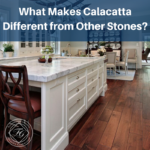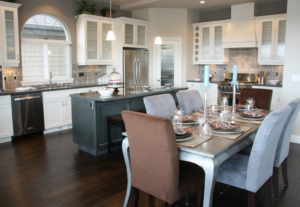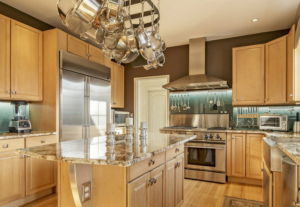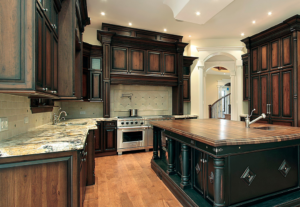
There are many reasons to buy a stone countertop, as opposed to the many other substances that one might use. If you look at all the oldest monuments from the ancient world, all of them are made of stone. That’s because only a stone can last through the ages after everything else has rotted away. Of course, there are many different types of stone. It is important to pick the right one, and the purpose of this article is to help you do just that.
We will now examine one of the more common options: Slate. This is perhaps one of the most useful stones in the world, due to its unique tendency to split into flat pieces. It has been used for roofing tile, chalkboards, and a lot of other things, but today we are concerned only with its use as a countertop material.
Factor 1: Price
Slate is a fairly inexpensive stone. It may not have the classy appeal of marble, but it will definitely save you some money. To give you an idea of how cheap this stone is, let’s compare some prices. We will start with this slate tile, which sells for about $6.30. Since the piece is 12 inches by 24 inches, that means we would be paying $3.15 per square foot. That is amazingly cheap, but we need to remember that not all slate is the same.
For instance, here are some tiles made of green slate, which is easily one of the most attractive types. In this case, you get a box of tiles for about $127. In the end, you’re paying about $13.50 per square foot. However, green slate is probably the most expensive type. Thus, you can plan on paying somewhere between $3.15 and $13.50 per square foot of slate.
Let’s compare it to some of the other options. Marble tends to be the most expensive, so let’s examine these marble field tiles. As you can see, these things will set you back about $26 per square foot, though not all marble is that expensive. Granite prices will vary a lot depending on the type, but the better kinds are almost as expensive as marble. For instance, these granite tiles will cost you about $22.50 per square foot.
Factor 2: Durability
When it comes to durability, slate is a mixed bag. On the one hand, it presents a non-porous and waterproof surface, which explains the long history of slate being used for roofing tiles. Thus, you won’t need to worry about sealing this one. Not only that, but the non-porous surface of this stone cannot absorb liquids. Anything that is spilled upon it will just roll off the surface rather than soaking into the stone. This eliminates nearly all danger of staining.
Slate is also chemically neutral. This means that you don’t have to worry about spilling acidic substances like orange juice or wine on your counter. For this reason, slate has often been used for laboratory counters. If you really want to get a good idea of how tough this stone is, take a look at this old book of building standards. According to this, slate roofing tiles should last from 20 to 100 years.
Let’s consider the hardness of this stone, as that will have a lot to do with its durability. As we can see from this well-sourced article, slate is hard enough to scratch glass and steel. Scientists rate the hardness of a substance using the Mohs scale. For comparison, soapstone usually has a Mohs value of 1. Slate, by contrast, has a Mohs rating of 5.5. That’s harder than marble, limestone, or travertine, and nearly as hard as granite.
When we look at this report, we can see why slate is so hard. For one thing, it’s composed of a mixture of hard materials like feldspar, muscovite, and quartz. For another thing, it has a very fine grain structure. You see, all stone has a natural grain just like wood, and the structure of this grain has a lot to do with its strength. Large grains make for a brittle substance, while a fine-grained substance like this will be stronger. This same rule applies to stone, wood, and metal.
Factor 3: Appearance
In terms of appearance, slate offers a plainer surface than most. Sometimes, it will just be a single flat color, but some people like that kind of look. If you want something a little bit more colorful, it is possible to find slate that has striations, marbling, and other surface variations. However, you are likely to pay more for such stone.
We have to be honest here: Slate does fall short in the area of beauty. Although it does look nice, it’s not quite as beautiful as the competition, which has a lot to do with the reduced price.
Factor 4: Maintenance
Under most circumstances, slate countertops will require little to no maintenance. This is one of its main strengths. According to this respected home builder, slate requires no maintenance other than basic cleaning.
However, we should mention that importance of getting a good slate slab. There are multiple grades of slate, and some of them are less durable than others. Low-grade slate will generally be more brittle, but this isn’t the biggest problem. The biggest problem is the fact that low-grade slate can absorb water. The waterproof nature of slate is one of its main selling points, so don’t negate it by getting bargain-basement stone.
Conclusion
As you can see, slate has a few significant upsides to offer. First of all, it might be the best choice for those on a tight budget. Of course, the higher-grade slate should be avoided in such a case. At the same time, you have to be careful about the grade of your slate counter, but you can get around this problem by ordering a sample first (which is common practice in this industry).
As for downsides, a relative lack of color and beauty are the only reasons that this stone is not more commonly used. So, if you aren’t that worried about having a colorful surface, and you want something that will do a good job at a low price, this might be the perfect choice for you. If you would like to know more about this and other fascinating subjects, please fill out the contact form below.






